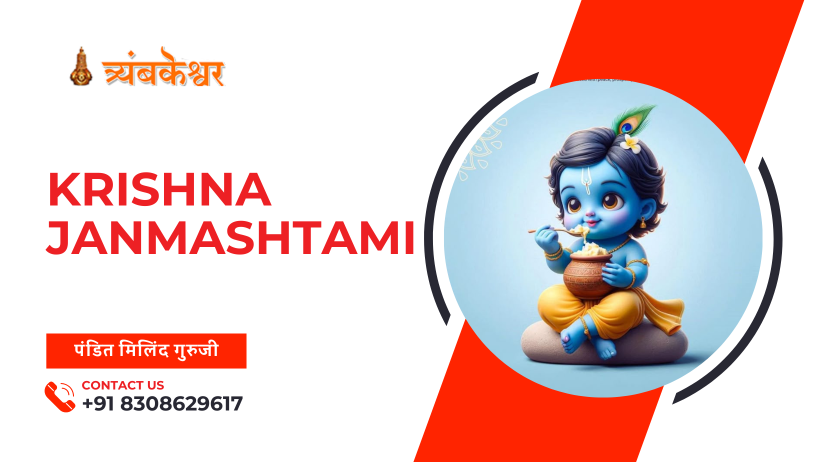
- January 1, 2025
- Pandit Milind Guruji
- 0
Krishna Janmashtami 2025: Celebrating the Birth of Lord Krishna with Devotion and Joy
Krishna Janmashtami is one of the most vibrant and spiritually significant festivals celebrated by Hindus around the world. It marks the divine birth of Lord Krishna, the eighth incarnation of Lord Vishnu, who took human form to establish dharma (righteousness) and destroy evil. Observed on the Ashtami (eighth day) of the Krishna Paksha (waning phase of the moon) in the month of Shravan or Bhadrapada (August-September), Janmashtami is a time for deep devotion, joyous celebration, fasting, and elaborate rituals.
This blog provides a complete guide to Krishna Janmashtami 2025, including its history, spiritual significance, customs, fasting rules, puja rituals, celebration ideas, and frequently asked questions.
The Spiritual Significance of Krishna Janmashtami
Lord Krishna’s birth was no ordinary event—it was a cosmic intervention to restore balance on Earth. He was born in a prison cell in Mathura to Vasudeva and Devaki, under the tyrannical rule of King Kansa. Krishna’s life, teachings, and divine leelas (miracles) serve as a guide to righteous living.
His message in the Bhagavad Gita—focused on karma, devotion, and detachment—is celebrated widely during this festival. Janmashtami reminds devotees to live a life of love, faith, and discipline.
Krishna Janmashtami 2025 Date and Muhurat
In 2025, Krishna Janmashtami falls on Friday, August 15, 2025.
Nishita Puja Time: 12:01 AM to 12:45 AM (August 16)
Ashtami Tithi Begins: 11:59 AM on August 15, 2025
Ashtami Tithi Ends: 2:32 PM on August 16, 2025
Note: The exact puja time may vary by location. Check your local Panchang or consult a priest.
Janmashtami Rituals and Traditions
1. Fasting (Upvas)
Devotees observe a strict fast, which may include water-only (nirjala), fruit-only (phalahar), or milk-only fasts. The fast continues until midnight, the believed time of Lord Krishna’s birth.
2. Puja Vidhi (Ritual Process)
Clean the home and decorate the puja room with flowers, mango leaves, and rangoli.
Place an idol or image of baby Krishna (Baal Gopal) in a cradle.
Offer flowers, incense, lamps (diya), Panchamrit (milk, curd, ghee, honey, sugar), and bhog (sweets like makhan, panjiri).
Sing devotional songs (bhajans) and chant mantras such as “Om Namo Bhagavate Vasudevaya.”
At midnight, bathe the Krishna idol with Panchamrit and dress him in new clothes and jewelry.
Rock the cradle and break the fast with prasadam.
3. Dahi Handi
Popular especially in Maharashtra, Dahi Handi involves forming human pyramids to break a pot of curd, symbolizing Krishna’s mischievous nature as ‘Makhan Chor.’
Regional Celebrations of Janmashtami
Mathura and Vrindavan
These cities come alive with grand festivities, temple decorations, Raas Leelas (dramatic enactments), and midnight celebrations.
Maharashtra
The Dahi Handi festival draws large crowds, with teams (Govindas) competing for prizes.
Gujarat
Devotees engage in Garba and Dandiya Raas, dressing as Krishna and Radha.
South India
People decorate cows, draw baby Krishna footsteps from the door to the altar, and make butter-based sweets.
ISKCON Temples
ISKCON temples across the globe celebrate with elaborate kirtans, dance dramas, and spiritual discourses.
Foods and Sweets Offered to Lord Krishna
Lord Krishna is fond of milk, butter, and sweets. Common offerings include:
Makhan Mishri
Panchamrit
Panjiri
Kheer
Ladoo
Murukku and seedai (in South India)
Chappan Bhog (56-item feast)
Krishna Janmashtami Bhajans and Mantras
Bhajans and mantras play a crucial role in invoking the divine energy of Krishna. Devotees sing:
“Achyutam Keshavam Krishna Damodaram”
“Govind Bolo Hari Gopal Bolo”
“Hare Krishna Hare Rama” Maha Mantra
These devotional songs enhance the spiritual atmosphere and inspire collective devotion.
Krishna Janmashtami Decoration Ideas
Decorate the puja area with peacock feathers, flutes, butter pots, and Radha-Krishna posters.
Use blue, yellow, and white floral themes.
Place small footsteps (alpona or rangoli) from the entrance to Krishna’s cradle.
The Teachings of Krishna for Modern Life
Krishna’s philosophy holds immense relevance today:
Detachment in Action: Perform your duty without attachment to results.
Devotion and Surrender: True peace lies in surrendering to the divine.
Dharma and Justice: Always uphold truth and righteousness.
Janmashtami is not just a celebration; it’s a spiritual opportunity to realign with these values.
Engaging FAQs About Krishna Janmashtami
Q1. Why is Janmashtami celebrated at midnight?
Because Lord Krishna is believed to have been born at midnight, devotees perform puja during that time.
Q2. Can children observe Janmashtami fast?
Children may observe a light fast (phalahar) under parental guidance.
Q3. Is Dahi Handi a religious ritual?
It’s a cultural celebration reflecting Krishna’s playful nature but not a mandatory religious practice.
Q4. What is Chappan Bhog?
It is a special offering of 56 food items to please Lord Krishna.
Q5. How is Janmashtami celebrated outside India?
ISKCON temples and Hindu communities worldwide organize events, pujas, kirtans, and feasts.
Final Thoughts
Krishna Janmashtami is a beautiful blend of devotion, culture, and festivity. It gives devotees an opportunity to relive the divine episodes of Lord Krishna’s life and implement his timeless teachings. From elaborate midnight rituals to energetic Dahi Handi events, this festival has something for everyone—be it spiritual depth or community bonding.
As Janmashtami 2025 approaches, may the birth of Krishna bring light, joy, and dharma into your life. Prepare early, involve your family, and celebrate this festival with unwavering faith and joy.
